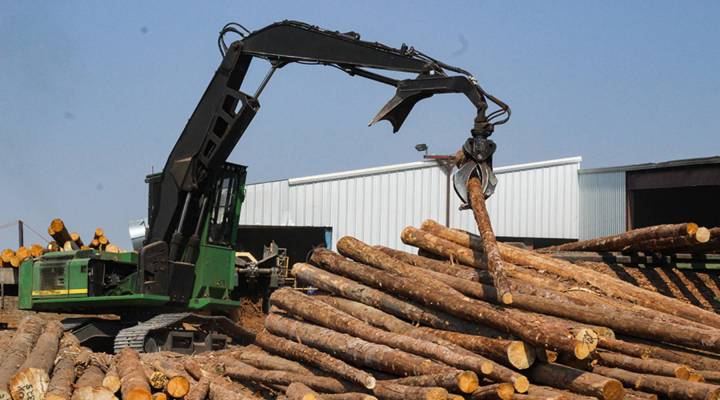
Lumber trade dispute and tariffs boost U.S. wood products

Back in 2012, one of the major employers in Montrose, Colorado, a sawmill, was in receivership and on the brink of collapse. At the time, local media reported that the cost of logging timber had become prohibitively expensive, and the log yard was nearly empty.
These days, logs are stacked high next to a humming mill. This year, it’s on track to turn out over 90 million board feet of lumber, a new record. To meet the growing demand for lumber, saw mill owner Jim Neiman has workers pulling 10-hour shifts instead of eight and is planning to invest $20 million in upgrades — something he never would have dreamed of a few years ago.
After years of stagnation, the price for U.S. lumber hit a record high in June, according to industry publication Random Lengths. Rural communities with softwood sawmills are booming. The Montrose Economic Development Corp. estimates the sawmill generates 250 direct jobs and adds $32 million to the local economy.
Neiman is glad for the success.

Owner Jim Neiman bought the sawmill back in 2012, when it was struggling to stay open. He’s the owner of three other sawmills in Montana and Wyoming, and the third generation in his family to run the company.
“There’s a number of factors, the market’s one,” he said. “The Canadian tariff is a big part of it.”
He’s referring to a little-known and long-running trade dispute between the United States and Canada — one that wasn’t started by President Donald Trump. The tariffs (technically duties) average 21 percent and have been in place since April 2017. Some experts say it’s allowed U.S. lumber producers to raise prices. Others say increased demand for new homes and supply shortages due to wildfires have played a bigger role.
For decades, Canada has been a major exporter of softwood lumber to the U.S. market — pine and spruce trees used primarily to frame homes and buildings. After the last lumber trade agreement expired in 2015, the countries were unable to negotiate a new one.
So the U.S. lumber industry petitioned the U.S. Department of Commerce, saying it had been unfairly harmed by cheap wood coming across the northern border. The agency agreed and imposed the duties.
Neiman said companies like his just want a fair deal, and these tariffs level the playing field.
“When another country can supply wood cheaper into this country than we can, something’s wrong,” he said.
Ripple effects
Neiman said the dispute is fundamentally about who controls the lumber market in both countries.
“I’m not going to kick their system, they’re just two totally different systems,” he said.

Worker Bob Calvert repairs the blades used for trimming and cutting the wood. He said the recent boom due to the softwood lumber tariffs is good for his industry, but it’s also good for Montrose.
The United States argues Canada can produce cheaper lumber in part because it harvests timber from public lands, and the government determines the price. America logs mostly private lands, and lumber prices are all determined by the market.
The tariffs are great for the U.S. lumber industry, but Amanda Countryman, an agricultural economist at Colorado State University who specializes in international trade, said it’s had negative consequences for other sectors of the economy.
“The cost of protecting the lumber industry is paid for by Americans in the form of higher prices for lumber that make it more expensive to buy a home,” she said.
According to the National Association of Home Builders , the tariffs have added almost $9,000 to the cost of a typical new family home. The group didn’t specify what the typical home is.
That cost is felt by homebuilders like Cheri Witt-Brown. She’s the executive director for the Habitat for Humanity chapter in Greeley, Colorado, north of Denver. The group builds housing for low-income residents.
Recently Witt-Brown toured the site of a three-bedroom house under construction. It was a skeleton of fresh lumber. She pointed out the dozens of wooden studs, trusses and joists that are used in the walls, roof and floors.
Lumber is typically one of the highest line items on Witt-Brown’s budget, and this summer her lumber costs were about 30 percent higher than they were last fall.
“Being a nonprofit, every penny counts,” Witt-Brown said. “When you see those kinds of increases, we feel the pinch.”
This sort of cost would typically be passed on to the consumer in the private sector, but Witt-Brown said in the nonprofit world, it means this Habitat for Humanity can’t build as many homes.
This story originally ran on Harvest Public Media.
There’s a lot happening in the world. Through it all, Marketplace is here for you.
You rely on Marketplace to break down the world’s events and tell you how it affects you in a fact-based, approachable way. We rely on your financial support to keep making that possible.
Your donation today powers the independent journalism that you rely on. For just $5/month, you can help sustain Marketplace so we can keep reporting on the things that matter to you.












